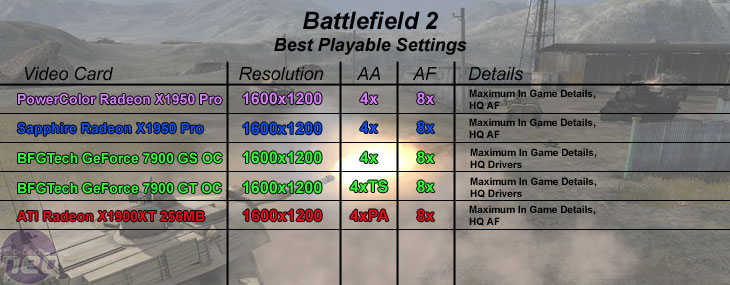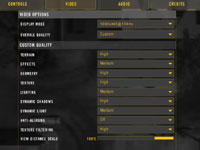
Battlefield 2
Publisher: Electronic ArtsBattlefield 2 features an all-new game engine based on the DirectX 9.0 API. There is no Shader Model 3.0 support, but the majority of hardware will use a Shader Model 2.0++ mode that includes support for Normal Maps, Parallax Mapping, Full-Resolution Dynamic Shadowing, Post Processing and Fog.
The game will look the same on both NVIDIA and ATI hardware, so there is no advantage of choosing one over the other in image quality related circumstances. The only major difference is that Ultra Shadow 2 is utilised on NVIDIA's hardware, while the shadowing on ATI hardware is done using a slightly different technique.
We patched the game to version 1.4 and then played three five-minute segments of the 'Strike at Karkand' map, reporting the median frame rate. We found that there was no ready way to duplicate testing situations manually in this game, so we felt that taking a typical slice of action from the game was the best way to report our findings. We controlled anti-aliasing from inside the game, while anisotropic filtering was set to 8xAF when the 'Texture Filtering' option was set to 'High'.
________________________________________________________________________________


In our ‘offline’ test scenario, we recorded a minimum frame rate of 30 frames per second and an average of 70 frames per second with 4x performance adaptive AA enabled. If we had recorded similar frame rates online, it would have delivered a more than acceptable gaming experience, but as we found out, online gameplay is considerably more stressful than playing BF2 in the single player mode.
The BFG Tech GeForce 7900 GS OC delivered a very similar gaming experience to the two Radeon X1950 Pro’s, but with a lower minimum frame rate. BFG Tech’s GeForce 7900 GT OC delivered the best gaming experience in this title, thanks to its ability to deliver smooth frame rates with 4x transparency supersampling AA enabled. The Radeon X1900XT 256MB was a close second, as we were unable to attain smooth gameplay with 4x quality adaptive AA applied; instead, we had to settle for 4x performance adaptive AA.

MSI MPG Velox 100R Chassis Review
October 14 2021 | 15:04









Want to comment? Please log in.